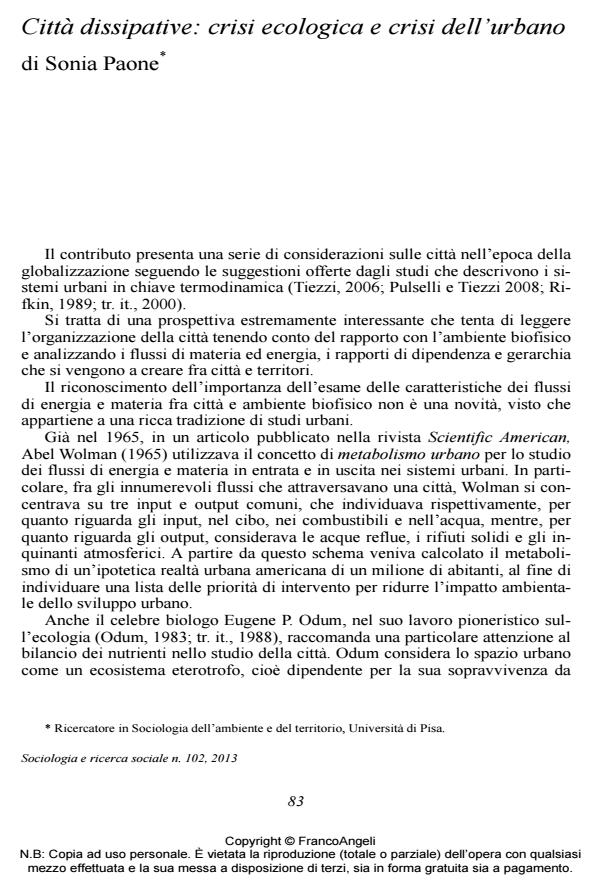Dissipative cities: Ecological Crisis and Urban Crisis
Journal title SOCIOLOGIA E RICERCA SOCIALE
Author/s Sonia Paone
Publishing Year 2014 Issue 2013/102
Language Italian Pages 12 P. 83-94 File size 497 KB
DOI 10.3280/SR2013-102006
DOI is like a bar code for intellectual property: to have more infomation
click here
Below, you can see the article first page
If you want to buy this article in PDF format, you can do it, following the instructions to buy download credits

FrancoAngeli is member of Publishers International Linking Association, Inc (PILA), a not-for-profit association which run the CrossRef service enabling links to and from online scholarly content.
The essay describes the relationship between ecological crisis and urban development, as analyzed by studies that describe urban systems using a thermodynamic perspective. The concept of city will be analyzed as a «dissipative structure» - an open system that discharges disorder outside in order to maintain internal order - and as an «incomplete ecosystem» - a system that can only function correctly over time if it draws on natural resources from external territories, which are therefore dominated and exploited. This perspective allows us to highlight the complex links between environmental issues and the organization and functioning of cities in a global context.
- A. Crosby (1972), The Columbian Exchange: Biological and Cultural Consequences of 1492, Westport, Greenwood Publishing; tr. it., Lo scambio colombiano. Conseguenze ecologiche e culturali del 1492, Torino, Einaudi, 1992.
- H.E. Daly (1990), «Towards Some Operational Principles of Sustainable Development», Ecological Economics, 2, pp.1-6, DOI: 10.1016/0921-8009(90)90010-R
- M. Davis (2006), Planet of Slums, London, Verso; tr. it., Il pianeta degli slum, Milano, Feltrinelli, 2006.
- R.H. Delavigne (1993), Il concetto di ecosistema urbano per una migliore comprensione delle problematiche ambientali: l’esempio dell’Ile-de-France, in M. Berrini, A. Cam- peol, F. Felloni, M. Magoni (a c. di), Aspetti ecologici della pianificazione del territorio, Brescia, Grafo.
- J. Diamond (2005), Collapse: How Societies Choose to Fail or Succeed, New York, Viking; tr. it., Collasso. Come le civiltà decidono di morire o vivere, Torino, Einaudi, 2005.
- J. Friedmann (1986), «The World City Hypothesis», Development and Change, 17, pp. 69-83, DOI: 10.1111/j.1467-7660.1986.tb00231.x
- J. Friedmann (1995), Where We Stand: a Decade of World City Research, in P.L. Knox, P.J. Taylor (eds.), World Cities in a World System, Cambridge, Cambridge University Press.
- F. Gesualdi (2003), Manuale per un consumo responsabile. Dal boicottaggio al commercio equo-solidale, Milano, Feltrinelli.
- M.C. Gibelli, E. Salzano (a c. di) (2006), No sprawl. I limiti dell’espansione urbana, Firenze, Alinea.
- J. Gottmann (1991), Dopo megalopoli la città globale: un’introduzione, in J. Gottmann, P.
- Muscarà (a c. di), La città prossima ventura, Roma, Laterza.
- B.F. Hoselitz (1955), «Generative and Parasitic Cities», Economic Development and Cultural Change, III, 3, April, pp. 278-294.
- R. Koolhaas (1997), «La città generica», Domus, 791, pp. 3-10.
- S. Low (2003), Behind the Gates: Life, Security and the Pursuit of Happiness in Fortress America, New York, Routledge.
- E.P. Odum (1983), Basic Ecology, Philadelphia, Saunders; tr. it., Basi di ecologia, Padova, Piccin, 1988.
- S. Paone (2008), Città in frantumi. Sicurezza, emergenza e produzione dello spazio, Milano, FrancoAngeli.
- I. Prigogine (1993), Le leggi del caos, Roma-Bari, Laterza.
- R.M. Pulselli, E. Tiezzi (2008), Città fuori dal caos. La sostenibilità dei sistemi urbani, Roma, Donzelli.
- J. Rifkin (1989), Entropy: Into Greenhouse World, New York, Bantam; tr. it., Entropia, Milano, Baldini e Castoldi, 2000.
- U. Rossi, A. Vanolo (2010), Geografia politica urbana, Bari-Roma, Laterza.
- S. Sassen (1994), Cities in a World Economy, Thousand Oaks, Pine Forge Presse; tr. it., Le città nell’economia globale, Bologna, il Mulino,1997.
- S. Sassen (2006), Perché le città sono importanti, in R. Burdett (a c. di), Città. Architettura e società, Padova, Marsilio.
- R. Sennett (2006), Capitalism and the City: Globalization, Flexibility and Indifference, in Y.
- Kazepov (ed.), Cities of Europe. Changing Contexts, Local Arrangements and the Challenge to Urban Cohesion, Oxford, Blackwell.
- J.A. Tarr (2002), «The Metabolism of the Industrial City», Journal of Urban History, 28, pp. 511-45, DOI: 10.1177/0096144202028005001
- E. Tiezzi (2006), Verso una fisica evolutiva. Natura e tempo, Roma, Donzelli.
- UN-Habitat (2003), The Challenge of Slums: Global Report of Human Settlements, London, Earthscan.
- Aa.Vv. (2011), Cities, Special Issue of Scientific American, September.
- P. Bairoch (1985), De Jérico à Mexico. Villes et économie dans l’histoire, Paris, Gallimard.
- P. Berdini (2009), Il consumo di suolo in Italia: 1995-2006, http://www.eddyburg.it.
- J. Borja, M. Castells (1997), Local y global, Madrid, Taurus; tr. it., La città globale, Novara, De Agostini, 2002.
- F. Braudel (1979), Civilisation máterielle, économie et capitalisme, Paris, Armand Colin; tr. it., Civiltà materiale, economia e capitalismo, Torino, Einaudi, 1982.
- United Nation Population Fund-Unpf (2007), State of the World Population 2007. Unleashing the Potential of Urban Growth, New York, Earthscan.
- J. Veron (2006) L’urbanisation du monde, Paris, La Découverte; tr. it., L’urbanizzazione del mondo, Bologna, il Mulino, 2008.
- M. Wackernagel, W.E. Rees (1996), Our Ecological Footprint:Reducing Human Impact on the Hearth, Gabriola Island, New Society Publishers; tr. it., L’impronta ecologica.
- Come ridurre l’impatto dell’uomo sulla terra, Milano, Edizioni Ambiente, 1996. A. Wolman (1965), «The Metabolism of Cities», Scientific American, 3, pp. 178-90.
- Worldwatch Institute (2007), State of the World 2007. Il nostro futuro urbanizzato, Milano, Edizioni Ambiente.
- Wuppertal Institut (1999), Futuro sostenibile. Riconversione ecologica. Nord-Sud, nuovi stili di vita, Bologna, Emi.
Sonia Paone, Città dissipative: crisi ecologica e crisi dell’urbano in "SOCIOLOGIA E RICERCA SOCIALE " 102/2013, pp 83-94, DOI: 10.3280/SR2013-102006